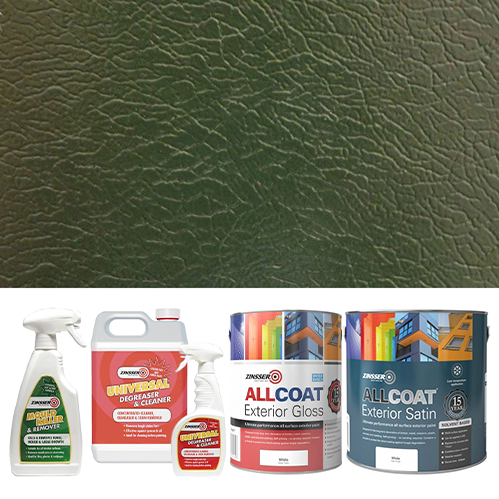Plastisol can be difficult to paint over as it requires coatings with good adhesion to stick to the surface. Our 3-step guide is easy to follow and shows you how to prepare, prime and finish plastisol with Zinsser Allcoat Exterior, an ultimate performance plastisol paint with outstanding adhesion that is available in Satin and Gloss finishes in over 4,000 colours.
Contents
Click on a link below to jump to the section:
Step 1. Surface Preparation / Sealing
Step 2. Patch Priming, Bring Forward and Priming
The Benefits
Plastisol is commonly used in cladding for industrial and commercial premises to protect and decorate buildings and is able to be coated in any colour to match company branding schemes or existing décor.
In environments with high exposure to corrosion, UV and extreme weather, plastisol requires regular maintenance and inspections – but with the correct primers and topcoats it can be protected for up to 15 years.
For businesses on retail parks with huge outlets and warehouse-style stores, it’s important to keep the exterior clean and tidy to attract customers looking for a little retail therapy, maintaining your reputation. Warehouses and factories on industrial estates should also look to maintain the exterior of the building as, particularly in remote locations, a run-down appearance can attract anti-social behaviour, including graffiti such as tagging.
Plastisol cladding can be found on:
- Warehouses
- Workshops
- Factories
- Industrial units
- Farm outbuildings
- Retail outlets
- Train sheds
It is also used as a coating on outdoor furniture and roofing.
Zinsser listens to contactors and develops new products – or adds features to existing products – to meet their changing needs, delivering world class products that meet “real world” challenges, providing tried and tested solutions to painting problems, such as painting plastisol.
Step 1. Surface Preparation / Sealing
The plastisol surface must be clean, dry and free from anything that will interfere with the adhesion of the materials to be applied. Remove loose and failing material by scraping or brushing with a stiff bristle brush to a sound edge, and then feather with a fine grade abrasive paper.
All visible signs of organic growth must be removed, treating the areas with Zinsser Mould Killer & Remover in accordance with the manufacturer’s instructions and allowing the surface to dry.
Any areas with remaining sound paint should be cleaned down with Zinsser Universal Cleaner & Degreaser to remove any contaminants, rinsing thoroughly with clean water to remove all residues, and allow to dry.
Please note: Plastisol should be fully weathered; if in doubt a test should be carried out on a small area and assessed for adhesion to determine suitability for painting.
Please contact our technical team a call on 0113 2455450 (option 2) or send a message to [email protected] if you require help painting plastisol.
Step 2. Patch Priming, Bring Forward and Priming
Patch prime all bare areas with Zinsser Allcoat Exterior (Satin or Gloss), in accordance with the manufacturer’s instructions, allowing a minimum drying time of 1 hour in normal drying conditions.
Bring forward patch primed areas with more Zinsser AllCoat Exterior and allow to dry.
Prime the plastisol overall with one full coat of Zinsser AllCoat Exterior Satin or Gloss in accordance with the manufacturer’s instructions and allow a minimum drying time of 1 hour (in normal drying conditions).
Step 3. Decoration
Now the plastisol surface has been prepared and suitably primed it can be decorated with one to two coats of Zinsser Allcoat Exterior (Satin or Gloss), in accordance with the manufacturer’s instructions, in one of over 4,000 colours in RAL, NCS and BS shades.
Allow a minimum drying time of one hour between coats.
More Information
If you require more advice on painting plastisol, give our technical team a call on 0113 2455450 (option 2) or send a message to [email protected].
 Rawlins Paints Blog Industrial Paint Tips, Guidelines & DIY Articles
Rawlins Paints Blog Industrial Paint Tips, Guidelines & DIY Articles
